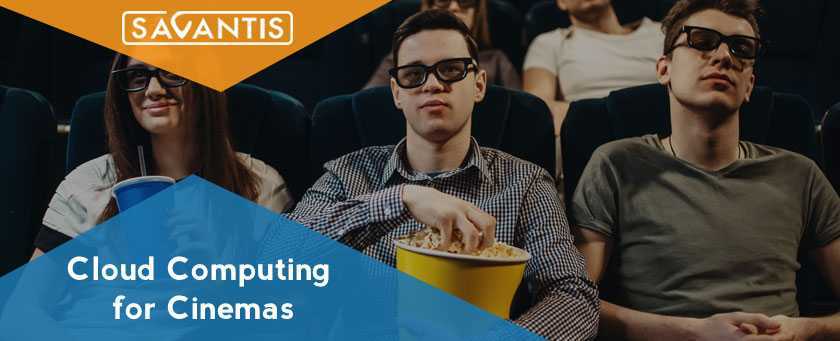Technology for cinemas can help speed up movie production and maintain audience excitement while maximizing revenue. And technologies such as cloud computing are rapidly becoming indispensable for driving these outcomes. According to Gartner, the worldwide public cloud services market is projected to grow 17.3 percent in 2019 to total $206.2 billion, up from $175.8 billion in 2018.
What is cloud computing?
A cloud model is one wherein tasks are processed and completed remotely for local results. This can be either public or private clouds. A public cloud is when the cloud provider supplies their customers with access to the shared environments they deploy. Contrary to popular belief, it does not mean that all your resources are publically accessible. A great example for this is the platform used by Amazon Web Services.
On the other hand, a private cloud involves cloud services provided over private IT infrastructure for the use of a single organisation, and is typically managed internally. Hybrid cloud solutions allow a mix-and-match of the two with privacy for sensitive files and the scalability of the public cloud for others.
How does cloud computing help cinema?
Cloud computing can enable centralization of information, data, and processes to provide easy access and complete overview for cinemas. This can, in return, empower improved decision-making, integrated operations, and enhanced movie going experience. Let’s take a deep dive into the benefits that moving to cloud can bring in, for cinemas.
Remote Access
In today’s digital ecosystem, a film’s production crew and participating service partners are global. For collaboration between these different teams, physical transfer of data and film reels is often needed, meaning they are physically flown around the world as and when required. Needless to say, this is time-consuming, tedious, and expensive which causes delays.
Having access to the files remotely, saves time, effort, and money that could be spent elsewhere. Remote access also means real-time discussions and changes while being online with the necessary teams.
On-demand processing power
Heavy computing power is required in rendering – the process of assembling all the individual elements of a film to develop the finished product – combining audio, visual effects and filters with the video. Depending on frame rates, 3D, photo-real reconstruction, and level of detailing of models and textures required in rendering the final frames, the memory and processing power needed is much higher than what is available on standard computers.
Cloud computing can be used to complete projects in a much quicker time frame by using remote computing power for the rendering processes.
Scalability and Storage
This kind of processing power gives smaller studios the chance to compete with the biggest names in the world. The potential to produce or create something on the same scale as a pioneer in the field is enticing.
Digital film making while offering many new avenues to explore, brought with it file sizes that smaller studios simply weren’t equipped to handle. The processing power required to create special effects in a film in this century is equivalent to supercomputing. On an average, a film being produced could grow to a petabyte of data – that’s the equivalent of 1,000 terabyte hard drives.
This data is by no means stagnant. It is manipulated in the post-production stage, uploaded, and downloaded by various teams involved. So, the benefits of having the files somewhere remote, with access and computing power is an inevitability.
Security
With its computing power and remote access, the cloud offers an elegant solution but brings with it the question of security. The problem is compounded with highly anticipated movies pirated and available online illegally before they hit the screens. On an average, pre-release piracy causes a 19.1% decrease in revenue compared to piracy that occurs post-release.
To combat this, several studios are investing to create their own, private clouds, where they don’t have to worry about the public or other studios gaining access to their systems. This is essentially a mammoth project, both in size and investment for these studios to undertake, but given that it can guarantee the security of their files, it is more than enough reason to spend. But given the price, plenty of studios opt to buy from experts in the field rather than build their own systems.
Streamline Operations
An intelligent cloud system can help with operations — starting with film distribution from theatrical planning, booking, and settlements to creating a more seamless customer-centric approach. Cloud computing allows evaluation of comparable films to individual theater performance, giving distributors insights to ensure a successful release.
Leveraging real-time access to data helps streamline operations, eliminate information delay, and enable an accelerated response, driving down costs. This offers a cohesive way for marketing, booking, and other teams to work together towards release.
Conclusion
Choosing a system that works for you is important. The software should be easy to use, offering differential access, with visibility to all team members at all times. Such a system eliminates the need for personnel as it will be maintained by the provider.
Cloud computing connects your front desk functions with back-end operations to increase employee productivity, turn real-time data into action, and integrate business processes. This, in turn, helps in creating and maintaining a customer-centric experience at the multiplex.
At Savantis, we work towards understanding your needs, enabling digital transformation and delivering significant innovation and expertise. As an SAP Gold Partner, we address the unique business needs of cinemas through innovation and deep knowledge, aided by intelligent cloud based systems like S/4HANA. Feel free to get in touch with us for more questions.


